Dariush Borbor
| Dariush Borbor | |
|---|---|
.jpg) Dariush Borbor | |
| Born |
April 28, 1934 Tehran |
| Alma mater |
University of Liverpool University of Geneva |
| Occupation | Architect |
| Awards |
Gold Mercury International Award (1976) Royal Pahlavi Prize (1977) 50 Outstanding Architects of the World (1988) |
| Buildings |
Urban Renewal of Mashhad City Centre (1968) Commercial Centre Bazaar Reza (1976) Museum and Library (1976) |
Dariush Borbor (Persian: داریوش بوربور, born April 28, 1934), is an Iranian-French architect, urban planner, designer, sculptor, painter, researcher and writer.[1][2][3] In 1963, Borbor established his own firm under the name of Borbor Consulting Architects, Engineers, City Planners. In 1976, he set up Sphere Iran, a consortium of four specialist consulting firms, and proposed a comprehensive National Environmental Master plan for Iran.[4] In 1992, he created the Research Institute and Library of Iranian Studies (RILIS) where he is the director.[5][6]
Borbor is widely regarded as one of the avant-garde architects of the modern movement in Iran;[7][8] a pioneer of modern urban planning,[9][10] named by some as "father of modern urban planning",[11][12][13][14] and a key figure in the promotion and creation of the High Urban Planning Council (1966, Persian: شورای عالی شهرسازی).[15][16] He was described by Swiss architectural critic Anthony Krafft as "one of the most innovative architects who is perhaps on the way of creating a Persian architectural style of the 20th century";[8] and French architectural critic Michel Ragon defined him as "the architect in search of a modern Iranian architectural style".[7] He has won many competitions and received several international prizes and awards, including the Gold Mercury International from Italy,[17] 50 Outstanding Architects of the World from the Second Belgrade Triennial of World Architecture,[18] and the Pahlavi Royal Award.[19]
Early life
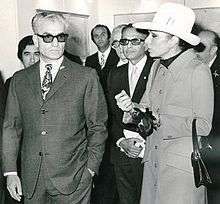
Dariush Borbor was born in April 1934. His father was Gholam Hossein khan Borbor (Persian: غلامحسین خان بوربور), one of the directors of the Iranian branch of the former Anglo-Iranian Oil Company (AIOC), congressman, ambassador-at-large, and one of the founding members of the Grand Lodge of Iran.[20] Borbor had his primary schooling in Iran. At the age of thirteen he moved to the United Kingdom for his secondary education, after which he obtained his General Certificate of Education from University of Cambridge (1952), a Bachelor of Architecture (1958) and a Master of Civic Design (1959) both from the University of Liverpool.[21] He then went to specialize on architecture of hot dry regions at the University of Geneva (1959) under the direction of the French architect and urban planner Eugène Beaudouin.[22]
Career

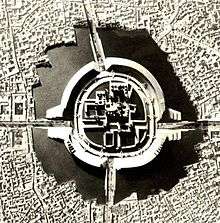
While working for his PhD, he collaborated concurrently with the Swiss urban planner Professor Arnold Hoechel and the architects Frei and Hunziker on several projects, including the first automatic bowling alleys in Meyrin Commune, Geneva, and Beirut, Lebanon.[5]
In 1961, he returned to Tehran as Deputy Technical Director of Iran-Rah, the largest Construction Co. of its time in Iran. In 1963, he created his own firm under the name of Borbor Consulting Architects, Engineers, City Planners.[24] As President and managing director, he developed and expanded the business to a large multidisciplinary organization with several in-house departments which included: architecture, urban planning, environment, structure, mechanics, electricity and interior design.[2] The firm employed a large number of highly qualified multi-national staff and included branch offices in several major cities in Iran.[25][5]
A few months prior to the 1978 Iranian Islamic Revolution, Borbor moved to Paris, France where he founded the Borbor International Management Consultants (BIMC) to Architects, Engineers, Planners. BIMC offered consultancy services in design, management and documentation to architectural and planning firms.[26] In 1984, he moved to Los Angeles where he was involved in some architectural consultancy and research on Iranian and Persianate subjects.[6]
Borbor returned to Iran in 1991 and established the Research Institute and Library of Iranian Studies (RILIS), a non-profit, non-political, private and independent institution dedicated to the promotion of research in the field of Iranian and Persianate studies with special emphasis on novel and creative research[27][5][28]
Prizes and awards
- 1958, Working Drawing Award, Architects' Journal, London, UK[29]
- 1959, First Prize, ideas competition for a Liverpool neighbourhood, Department of Civic Design, University of Liverpool, UK[30]
- 1965, First Prize, design of Persian Pavilion, Los Angeles
- 1975, Gold Mercury International Award for project management, Rome, Italy[31]
- 1976, NIOC Award, seaside resort, Mahmoudabad, Caspian coast, Iran
- 1976, First Prize, 2200-unit shopping mall (Bazaar Reza, Persian: بازار رضا) in Mashhad, Iran[32]
- 1976, First Prize, monument, Mashhad, Iran.
- 1977, First Prize, Temple of the Grand Lodge of Iran, Tehran, Iran.[32]
- 1978, Pahlavi Royal Award, for design, construction and management, 2200-unit shopping mall (Bazaar Reza) in record eleven months[33]
- 1988, 50 Outstanding Architects of the World, the Second Belgrade Triennial of World Architecture[34]
Selected projects and writings
Architecture
Regional planning
Urban and landscape design
Bibliography
- "The Influence of Persian Gardens on Islamic Decoration", Architecture Formes Fonctions, vol. 14, ed. Anthony Krafft, Lausanne, Switzerland, 1968, pp. 84–91.[42]
- D.Bourbour [Borbor], Projet de Rénovation de Haram Hazrat-e-Reza à Meched, A.A. Honar va Me'mari, Tehran, 1972.
- "Iran", The Encyclopedia of Urban Planning, McGraw-Hill, New York, 1974, pp. 553–567.[12]
- "The Influence of Wine Culture in Iranian Architecture and the Region", Wine Culture in Iran and Beyond, Österreichischen Akademie der Wissenchaften (ÖAW) / Austrian Academy of Sciences, Vienna, 2014, pp. 259–275.[43]
- Dariush Borbor, Dariush Borbor Compendium of Articles, Presentations and Interviews 1954-2018, Sahab Geographic & Drafting Institute, Tehran, 2018.
Gallery
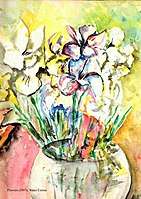 1953, "Flowers", Aquarelle (30 x 22 cm.) by Dariush Borbor
1953, "Flowers", Aquarelle (30 x 22 cm.) by Dariush Borbor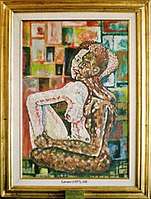 1957, "Lovers, Black and White in Unity" oil on canvas (60 cm. x 46 cm.) by Dariush Borbor, presented to Nelson Mandela in 2007 by the artist on the 50th anniversary of the painting
1957, "Lovers, Black and White in Unity" oil on canvas (60 cm. x 46 cm.) by Dariush Borbor, presented to Nelson Mandela in 2007 by the artist on the 50th anniversary of the painting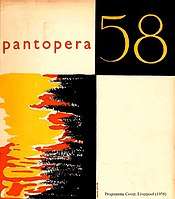 1958, Programme Cover, University of Liverpool, Liverpool, UK, designed by Dariush Borbor
1958, Programme Cover, University of Liverpool, Liverpool, UK, designed by Dariush Borbor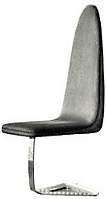 1961, Chair, Tehran Iran, designed by Dariush Borbor
1961, Chair, Tehran Iran, designed by Dariush Borbor 1961, Arjomand House and Medical Office, Kerman, Iran
1961, Arjomand House and Medical Office, Kerman, Iran 1962, "Flight" Sculpture in Copper (height 4 m.) at the Garden of the Royal Pavilion, Mehrabad Airport, Tehran, Iran, by Dariush Borbor
1962, "Flight" Sculpture in Copper (height 4 m.) at the Garden of the Royal Pavilion, Mehrabad Airport, Tehran, Iran, by Dariush Borbor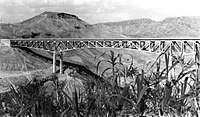 1962, Bridge (in association with Brian Colquhoun, Engineers), near Andimeshk, Khuzestan, Iran
1962, Bridge (in association with Brian Colquhoun, Engineers), near Andimeshk, Khuzestan, Iran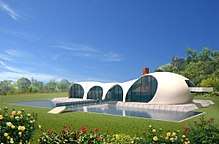 1963, House Abdoh, Farmanieh, Tehran, Iran
1963, House Abdoh, Farmanieh, Tehran, Iran 1964, Persian Pavilion, Restaurant, Los Angeles
1964, Persian Pavilion, Restaurant, Los Angeles 1964, Persian Pavilion, Persian Bath House, Los Angeles
1964, Persian Pavilion, Persian Bath House, Los Angeles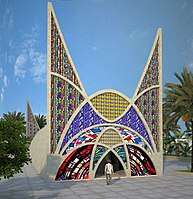 1964, Mosque, Ahwaz, Iran (the first mosque of modern architectural design in Iran by Dariush Borbor)
1964, Mosque, Ahwaz, Iran (the first mosque of modern architectural design in Iran by Dariush Borbor) 1965, House Dariush Borbor, Darous, Tehran, Iran
1965, House Dariush Borbor, Darous, Tehran, Iran 1965, BORBOR Consultants Executive Headquarters, Darous, Tehran, Iran
1965, BORBOR Consultants Executive Headquarters, Darous, Tehran, Iran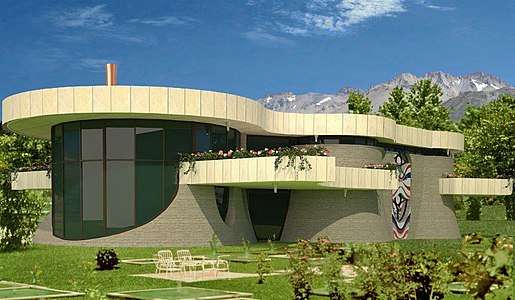 1965, House Nahavandi, Farmanieh, Tehran, Iran
1965, House Nahavandi, Farmanieh, Tehran, Iran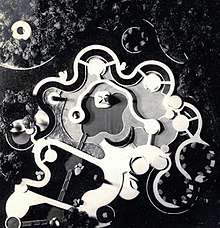 1966, Park No. 3, Ahwaz, Iran
1966, Park No. 3, Ahwaz, Iran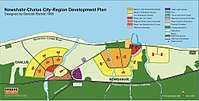 1966, Nowshahr-Chalus Regional Master Plan, Caspian Coast, Iran
1966, Nowshahr-Chalus Regional Master Plan, Caspian Coast, Iran 1968, Model of the Urban Renewal for Mashhad City Centre
1968, Model of the Urban Renewal for Mashhad City Centre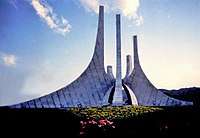 1971, Iconic Monument, Mashhad, Iran by Dariush Borbor
1971, Iconic Monument, Mashhad, Iran by Dariush Borbor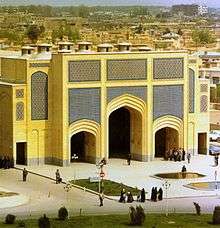 1976, Bazaar Reza Shopping Mall, South Entrance, Mashhad, Iran[44]
1976, Bazaar Reza Shopping Mall, South Entrance, Mashhad, Iran[44] 1976, Bazaar Reza Shopping Mall, General View of Exterior, Mashhad, Iran[44]
1976, Bazaar Reza Shopping Mall, General View of Exterior, Mashhad, Iran[44] 1976, Museum and Library, Mashhad, Iran
1976, Museum and Library, Mashhad, Iran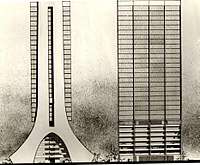 1977, a 32 Storey Residential Block, Residential Neighbourhood, including, 2000 Solar Heated Apartments and Associated Buildings, Mashhad, Iran
1977, a 32 Storey Residential Block, Residential Neighbourhood, including, 2000 Solar Heated Apartments and Associated Buildings, Mashhad, Iran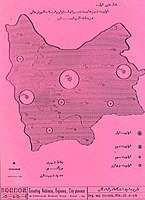 1977, Dariush Borbor, Architect, Urban Planner, Azarabadegan Regional University for the Ostan of Azerbaijan, Iran
1977, Dariush Borbor, Architect, Urban Planner, Azarabadegan Regional University for the Ostan of Azerbaijan, Iran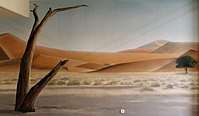 2002, "The Dunes of Iran" mural oil on plaster (5.00 m. x 2.75 m.), Elahieh, Tehran, Iran by Dariush Borbor
2002, "The Dunes of Iran" mural oil on plaster (5.00 m. x 2.75 m.), Elahieh, Tehran, Iran by Dariush Borbor 2002, Table in fibreglass and glass (3.00 m. x 1.30 m.) designed by Dariush Borbor
2002, Table in fibreglass and glass (3.00 m. x 1.30 m.) designed by Dariush Borbor
See also
References
- ↑ "ASPS Newsletter, no. 37, Fall 2016, pp. 6–7" (PDF).
- 1 2 "Dariush Borbor". Caoi.ir. September 23, 2016. Retrieved 2017-06-17.
- ↑ "20 Years of Iran and the Caucasus: A Breakthrough International Conference Dedicated to the 20th Anniversary of IRAN AND THE CAUCASUS". "China-Eurasia" Council for Political and Strategic Research. October 16, 2016. Retrieved 2017-06-09.
- ↑ "داریوش بوربور – دانشنامه مشهد". Mashhadenc.ir. June 20, 2014. Retrieved 2017-06-17.
- 1 2 3 4 "اخبار > داریوش بوربور ، چهره ماندگار در معماری ایران". Architects.ir. Retrieved 2017-06-17.
- 1 2 mashhadenc (June 20, 2014). "داریوش بوربور – دانشنامه مشهد". Mashhadenc.ir. Retrieved 2017-06-17.
- 1 2 Michel Ragon, Histoire Mondiale de l'Architecture et de l'Urbanisme Modernes, vol. 2, Casterman, Paris, 1972, p. 356.
- 1 2 Architecture: formes + fonctions. Books.google.com. November 10, 2010. Retrieved 2017-06-17.
- ↑ The Diplomat. Books.google.com. January 23, 2008. Retrieved 2017-06-17.
- ↑ Shams, Alex (September 12, 2016). "Iranians are heading to the beach in record numbers". Slate.com. Retrieved 2017-06-17.
- ↑ Behnegarsoft.com (September 24, 2014). "IBNA – International Congress of Iranologists in Montreal reviewed". Iran's Book News Agency (IBNA). Retrieved 2017-06-09.
- 1 2 "Abstracts and Bios – Forum for the Cultural Studies of Iran". forumfortheculturalstudiesofiran.wp.st-andrews.ac.uk. Retrieved May 19, 2017.
- ↑ "Biography, Dr. Dariush Borbor", From Persepolis to Isfahan: Safeguarding Cultural Heritage, Programme, Iran Heritage Foundatin (IHF), London, January 16-18m 2015, p. 14.
- ↑ "داریوش بوربور". Ammi.ir. Retrieved May 19, 2017.
- ↑ "Modeling Tehran – Majalla Magazine". Majalla Magazine. August 24, 2010. Retrieved 2017-06-09.
- 1 2 "Dariush Borbor", Encyclopedia of Urban Planning, ed. Arnold Whittick, McGraw-Hill, New York, 1974, p. viii.
- ↑ "Borbor Consulting Architects Presented with, Tehran Journal, Tehran, December 22, 1976, p. 2.
- ↑ Karolina Udovički; Aca Arsenijević; Milan Bosnić; Milan Kopanja; Ivica Mladenović, Drugi beogradski trijenale svetske arhitekture: [50 istaknutih arhitekata sveta] = The Second Belgrade Triennial of World Architecture: [50 outstanding architects of the world]: Beogradski sajam, hala 2, 4–12 juni/June 1988, Savez arhitekata, Beogard, 1988.
- ↑ "Design Prize", Tehran Journal, Tehran, September 7, 1976, p. 3.
- ↑ H.M. Zavosh, Dowlatmardān Iran va Sāxtār-e Nehādhā dar Dowrān-e Pahlavi, Našr-e 󠅡Ešāra, Tehran, 1370/2001, p. 102; Ghobad Fakhimi, Sī Sāl Naft-e Iran: Az Mellī Šodan tā Enqelāb Eslāmī, vol. 1, Mehrandīš, 1378/2009, p. 38;
- ↑ Iran Who's who, 3rd edition, Echo of Iran, Tehran, 1976, p. 113.
- ↑ "داریوش بوربور – دانشنامه مشهد". دانشنامه مشهد (in Persian). Retrieved 2017-06-09.
- ↑ "Manplan 5, Religion Part III: 'has religion a future?'". Retrieved June 17, 2017.
- ↑ "پروفایل اتووود شرکت بوربور مهندسین مشاور". Etoood.com. Retrieved 2017-06-17.
- ↑
- ↑ "Architects". architects.ir.
- ↑ "معمار خطوط آزاد | جدید آنلاین". Jadidonline.com (in Persian). July 20, 2010. Retrieved 2017-06-17.
- ↑ "Fall 2016 Newsletter" (PDF). Persianatesocieties.org. Retrieved 2017-06-17.
- ↑ "This years' competition winners", The Architects' Journal, July 25, 1957, p. 130.
- ↑ "Liverpool Reconstruction Scheme", The Town Planning Review, vol. XXX, no. 1, Liverpool University Press, April 1959, Liverpool, plates 2–3.
- ↑ "Borbor Consulting Architects Presented with International Gold Mercury Award from Italy", Tehran Journal, Tehran, December 22, 1976, p. 2.
- 1 2 "Iranian Studies Directory – Association for Iranian Studies". associationforiranianstudies.org. Retrieved May 19, 2017.
- ↑ "Design Prize", Tehran Journal, Tehran, September 7, 1976, p. 3.
- ↑ Karolina Udovički; Aca Arsenijević; Milan Bosnić; Milan Kopanja; Ivica Mladenović, Drugi beogradski trijenale svetske arhitekture: [50 istaknutih arhitekata sveta] = The Second Belgrade Triennial of World Architecture: [50 outstanding architects of the world]: Beogradski sajam, hala 2, 4–12 juni/June 1988, Savez arhitekata, Beogard, 1988.
- ↑ Kayhan International, May 15, 1967, p. 2.
- ↑ Leila Aminian (March 3, 2007). ""Meydan-e panzdah khordad Mashhad takhrib shod"". Iran Architecture & Urbanism News Agency. Retrieved 2017-06-17.
- ↑ "Museum and Library for Islamic Art and Books – Mashhad, Iran", Architecture Contemporaine, vol. 5, Editions Anthony Krafft, Lausanne, Switzerland, 1983, pp. 225–228.
- 1 2 "NOWŠAHR – Encyclopaedia Iranica". Iranicaonline.org. Retrieved 2017-06-17.
- ↑ "Has Religion a Future", The Architectural Review, the Architectural Press, London, March 1970, p. 189; https://www.architectural-review.com/rethink/campaigns/manplan/manplan-5-religion-part-iii-has-religion-a-future/10004748.article, Encyclopedia of Urban Planning|editor=Arnold Whittick|publisher=McGraw-Hill|location=New York|year=1974|pages=565–67
- ↑ Kayhan International, November 14, 1968, p. 3.
- ↑ "Mashad Commercial Center". Archnet.org. Retrieved 2017-06-17.
- ↑ "Find Free PDF ebooks and download online". Mediabokslut.se. Retrieved 2017-06-17.
- ↑ "Wine culture in Iran and neighbouring countries". May 16, 2015. Retrieved May 19, 2017.
- 1 2 "بازار رضا". June 3, 2017. Retrieved June 17, 2017 – via Wikipedia.
External links
- Official website
- Iran Contemporary Architect’s Site
- Persian Studies Seminars, University of Cambridge
- Iran Heritage Foundation (IHF), From Persepolis to Isfahan: Dariush Borbor
- The Architect of Free Lines, interview with Dariush Borbor (داریوش بوربور، معمار خطوط آزاد)
- BBC Hard Talk Special, interview with Dariush Borbor (به عبارت دیگر ویژه: گفتگو با داریوش بوربور)
- Iran Heritage Foundation (IHF), «A Comparative Analysis of Contemporary Architecture in Iran and the West» by Dr Dariush Borbor (Research Institute and Library of Iranian Studies), London, November 12, 2016, published on May 5, 2017
- Iran Heritage Foundation (IHF), «Different and Modern, yet Iranian» by Dr Dariush Borbor (BORBOR Consulting Architects, Engineers, Planners), London, November 12, 2016, published on May 5, 2017
- Iran Heritage Foundation (IHF), «Iranian Architects & Architecture: Panel discussion», London, November 12, 2016, published on May 5, 2017